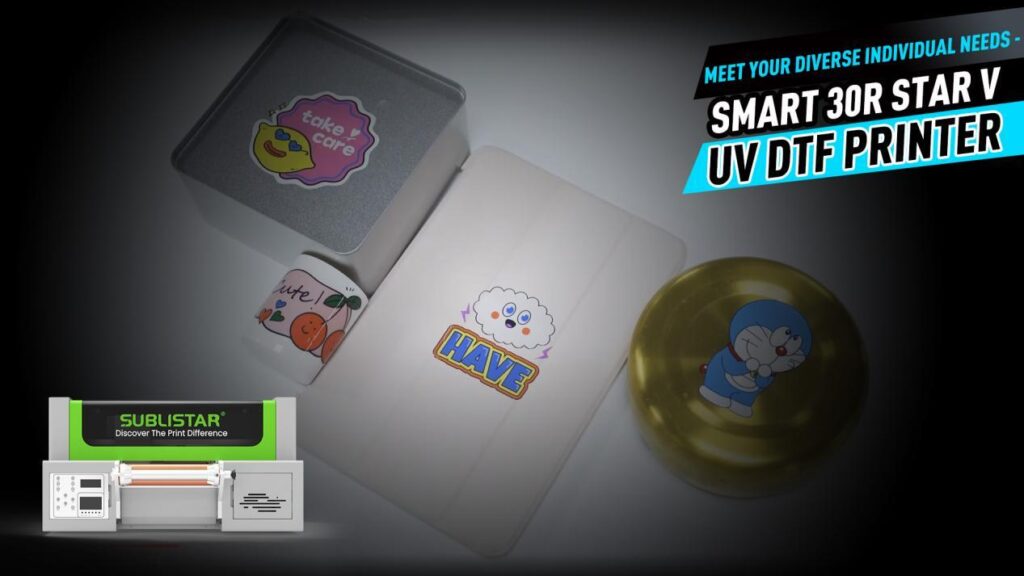Whats the same features for A3 UV DTF Printer and Roller UV DTF Printer?
In the printing industry, with the continuous progress of technology, UV DTF printers, as an innovative printing method, gradually occupy an important position in the market. Among them, A3 UV DTF printer and Roll UV DTF printer as the two main forms of UV DTF printing technology, each has a unique application scenario, but there are many similarities in function. This paper will deeply analyze the same functions of these two printers from the aspects of printing principle, application field, printing effect and operation convenience.
- The commonality of printing principles
Both A3 UV DTF printers and Roll UV DTF printers have a core printing principle based on UV curing technology. UV printing, or UV curing printing, is an advanced form of piezoelectric inkjet printing. In this process, the ultraviolet light emitted by the LED cold light source lamp reacts with the curing agent in the UV ink, prompting the pigment molecules to quickly solidify on the surface of the material to complete the printing action. This instant curing feature gives UV DTF printers significant advantages in printing efficiency and quality.
Specifically, both printers use UV ink as the main consumable, spraying the ink directly onto the printing medium via a high-precision nozzle. Subsequently, the UV light source quickly solidifies the ink without waiting for natural drying, greatly improving production efficiency. In addition, UV ink has the characteristics of bright color, strong weather resistance, wear resistance and scratch resistance, ensuring the high quality of the printed work.
- The breadth of the application field
The A3 UV DTF printer and the Roll UV DTF printer also show a high degree of commonality in the application field. They are suitable for printing in a variety of materials, including hard and soft materials.
Hard materials: such as glass, ceramics, metal, plastic, acrylic, etc. These materials have a smooth surface or matte texture, and it is often difficult to achieve high-quality pattern printing on them by traditional printing methods. The UV DTF printing technology successfully breaks this limitation through its unique curing method and ink characteristics, so that these hard materials can also show beautiful pattern effects.
Soft materials: Both the A3 UV DTF printer and the Roll UV DTF printer need to print on the AB film first, and then use the automatic coating function to output the printed crystal label in rolls. After manual cutting or manual cutting, tear off the B film, paste the pattern on the substrate, soft materials (such as cloth, leather, etc.) transfer also performs well. And these two continuous coil printing methods are very suitable for continuous operations in large-scale production, such as textile printing, leather products decoration and so on.
- The excellence of the printing effect
In terms of print results, both the A3 UV DTF printer and the Roll UV DTF printer show extremely high quality. This is mainly due to the excellent performance of UV ink and the precise control of the printer.
Bright colors: UV ink has a wide color gamut range, can present a more rich, vivid color effect. Whether it is bright red, bright yellow, or deep blue, calm black, can be perfectly restored.
Fine pattern: Both printers are equipped with high-precision sprinkler heads, enabling micron-level inkjet accuracy. This means that clear edges and smooth lines can be maintained even in complex pattern details, ensuring the overall beauty of the printed work.
Strong weather resistance: UV ink after ultraviolet curing, has good weather resistance, wear resistance and chemical resistance. This allows the printed work to maintain bright colors and clear patterns for a long time, and is not easy to fade or damage.
- Improve the ease of operation
As technology continues to advance, A3 UV DTF printers and Roll UV DTF printers have also made significant improvements in ease of operation.
Intelligent operation: Modern UV DTF printers are generally equipped with intelligent operating systems and touch screen interfaces. Users can complete pattern design, print Settings, equipment monitoring and other tasks through simple touch operation. This not only reduces the difficulty of operation, but also improves the work efficiency.
Automated processes: Both printers are highly automated from the material to the printing process. In particular, the Roll UV DTF printer, with its continuous coil printing, further simplifies the operation process, reducing the possibility of human intervention and errors.
Easy maintenance: The maintenance of UV DTF printers is also relatively easy. Most of the equipment is equipped with automatic cleaning and maintenance functions, users only need to follow the instructions for regular maintenance to keep the equipment in good working condition.
- Summary and outlook
In summary, the A3 UV DTF printer and the Roll UV DTF printer show a high degree of commonality in terms of printing principle, application field, printing effect and operation convenience. With UV curing technology as the core, they achieve high-quality printing on a variety of materials, meeting the market demand for personalized, high-quality printing products.
Looking to the future, with the continuous progress of science and technology and the constant change of market demand, UV DTF printing technology will continue to develop and improve. On the one hand, with the continuous emergence of new inks and printing materials, the printing effect and application field of UV DTF printers will be further expanded; On the other hand, with the in-depth application of intelligent and automation technology, the operation convenience and production efficiency of UV DTF printers will also be further improved.
In short, UV DTF printing technology, as an important form of UV printer, will play a more important role in the future printing industry. They will inject new vitality and momentum into the development of the printing industry with excellent printing results, a wide range of application fields and convenient operation methods.







